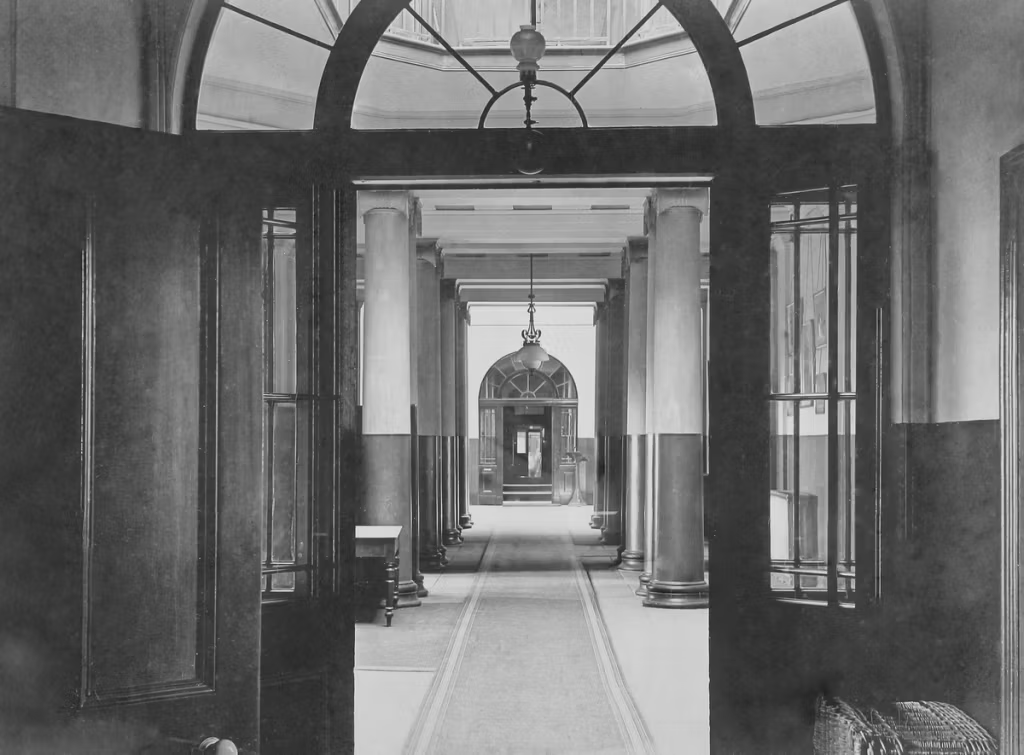

1749
Peter Collinson inherits Ridgeway House
Renowned botanist Collinson gains ownership of his father-in-law’s house, which will later become the site of Mill Hill Grammar School.

1805
The Founding Committee resolve to open a Non-Conformist School
Meeting in Batson’s Coffee Rooms in Cornhill, Reverend Pye-Smith, Samuel Favell and other Non-Conformist merchants begin their plans for the creation of a new educational enterprise.

1807
Mill Hill Grammar School opens
In the newly purchased Ridgeway House, the School welcomes 62 pupils in its first year.

1826
Mill Hill Grammar expands
To meet growing enrolment numbers, the Ridgeway House is demolished, and a new Mill Hill School building is constructed, designed by Sir William Tite.

1879
Former Prime Minister, Sir William Gladstone, serves as Guest of Honour
The former Prime Minister finds Mill Hill Grammar as 'an Institution strikingly alive.'

1898
Basil Champney’s Chapel is completed
Through the successful fundraising of Headmaster Sir John McClure, Mill Hill witnesses the completion of its third, and final Chapel, still used today.

1907
Mill Hill celebrates its centenary
By the end of its first century, Mill Hill has welcomed almost 1,000 pupils through its doors. The Prime Minister, Sir Henry Campbell-Bannerman, is welcomed as the Centenary Foundation Day Guest of Honour.

1912
Mill Hill welcomes new additions
Belmont, Mill Hill Junior House (later Mill Hill Preparatory), opens its doors, as well as the McClure Music School.

1920
The Fallen are honoured
Mill Hill’s Gate of Honour is opened and dedicated to alumni and members of staff who fell during World War I.
1924
Prince Edward, later King Edward VIII, opens the Science Building (Crick Building)
His Highness receives a warm welcome, a parade of the OTC troop and a tour of the new facilities, meeting pupil Cecil Goyder, who will go onto to make the first two-way international radio transmission a few months later.

1933
Mill Hill breaks with tradition and creates its first Day House
Murray was the first and only day house for several decades, welcoming future celebrities such as actor Patrick Troughton. It continues to thrive today.

1935
The College of Arms grants Mill Hill its first official crest
Whilst Mill Hill has had several unrecognised crests and mottos – including ‘excelsior’ – the first crest is awarded, with the motto ‘et virtutem et musas.’

1949
The Middlesex Scheme is implemented
The Scheme ensures that pupils from all backgrounds would have the chance to receive a private school education. Former Scheme pupils would go onto to set up the first Bursary Scheme at Mill Hill.

1957
Her Majesty, the Late Queen Elizabeth II, visits Mill Hill to celebrate its 150th anniversary
The Late Queen meets with pupils from all areas of school life – Monitors, Captains of Sports Teams, the OTC troop – and even takes tea with the Headmaster, Roy Moore, and his family at the Grove.

1975
Mill Hill welcomes girls into the Sixth Form
In another historic move, Mill Hill opened its doors to female day pupils – for the Sixth Form – an extraordinary move for the time, compared to other public schools who remained boys only.

1986
Prime Minister Margaret Thatcher visits Mill Hill
Mill Hill welcomes the first female Prime Minister, she tours the grounds and meets the editors of the Mill Hill Magazine.

1997
Mill Hill goes completely co-educational
As the first female boarding house, Cedars, opens its doors, Mill Hill, Belmont and Grimsdell all welcome female pupils across all the years.

2007
Bicentennial expansion
To celebrate its 200th anniversary, Mill Hill renovates its site. This includes the creation of a new humanities building, the Favell, opened by HRH Countess of Wessex.

2015
Mill Hill appoints its first female Head
Mrs Frances King is welcomed as the first ‘Head’ of Mill Hill, she oversees more renovations and improvements to the site.

2017
The Mill Hill crest and motto are unveiled
To modernise the School, the crest is updated and the motto translated to ‘Instilling Values, Inspiring Minds’. This brings our four Mill Hill based schools under a single crest.

2018
The new home of Middlesex Women and Girls’ Cricket
Mill Hill and Belmont Schools unveiled as the New Home of Middlesex Women and Girls’ Cricket. This innovative partnership will see the Middlesex Women and Girls’ sides playing the majority of their home matches at Mill Hill and Belmont.

2023
The Saracens Group and Mill Hill announces official partnership
The partnership will start by establishing an official pathway with the Saracens Men's Academy at Mill Hill School; providing a clear pathway to develop talented young rugby players within the school, with aspirations to play for the Saracens Men's team.

2023
Mill Hill Education Group is created
Mill Hill Education Group becomes the brand name for The Mill Hill School Foundation. This will ensure clear and unified branding for all Mill Hill’s partnership schools, which can be viewed here.

2023
David Benson is appointed Head of Mill Hill School
As the 31st Head of Mill Hill, David joins a long line of impressive leaders in Mill Hill’s illustrious history.














